Statistical feature extraction for artifact removal from concurrent fMRI-EEG recordings
- PMID: 22036675
- PMCID: PMC3254729
- DOI: 10.1016/j.neuroimage.2011.10.042
Statistical feature extraction for artifact removal from concurrent fMRI-EEG recordings
Abstract
We propose a set of algorithms for sequentially removing artifacts related to MRI gradient switching and cardiac pulsations from electroencephalography (EEG) data recorded during functional magnetic resonance imaging (fMRI). Special emphasis is directed upon the use of statistical metrics and methods for the extraction and selection of features that characterize gradient and pulse artifacts. To remove gradient artifacts, we use channel-wise filtering based on singular value decomposition (SVD). To remove pulse artifacts, we first decompose data into temporally independent components and then select a compact cluster of components that possess sustained high mutual information with the electrocardiogram (ECG). After the removal of these components, the time courses of remaining components are filtered by SVD to remove the temporal patterns phase-locked to the cardiac timing markers derived from the ECG. The filtered component time courses are then inversely transformed into multi-channel EEG time series free of pulse artifacts. Evaluation based on a large set of simultaneous EEG-fMRI data obtained during a variety of behavioral tasks, sensory stimulations and resting conditions showed excellent data quality and robust performance attainable with the proposed methods. These algorithms have been implemented as a Matlab-based toolbox made freely available for public access and research use.
Published by Elsevier Inc.
Figures














Similar articles
-
Development, validation, and comparison of ICA-based gradient artifact reduction algorithms for simultaneous EEG-spiral in/out and echo-planar fMRI recordings.Neuroimage. 2009 Nov 1;48(2):348-61. doi: 10.1016/j.neuroimage.2009.06.072. Epub 2009 Jul 4. Neuroimage. 2009. PMID: 19580873 Free PMC article.
-
Artifact removal in co-registered EEG/fMRI by selective average subtraction.Clin Neurophysiol. 2007 Nov;118(11):2437-50. doi: 10.1016/j.clinph.2007.08.017. Epub 2007 Sep 21. Clin Neurophysiol. 2007. PMID: 17889599
-
Removal of FMRI environment artifacts from EEG data using optimal basis sets.Neuroimage. 2005 Nov 15;28(3):720-37. doi: 10.1016/j.neuroimage.2005.06.067. Epub 2005 Sep 16. Neuroimage. 2005. PMID: 16150610
-
Concurrent electrophysiological and hemodynamic measurements of evoked neural oscillations in human visual cortex using sparsely interleaved fast fMRI and EEG.Neuroimage. 2020 Aug 15;217:116910. doi: 10.1016/j.neuroimage.2020.116910. Epub 2020 May 7. Neuroimage. 2020. PMID: 32389729
-
Recent advances in recording electrophysiological data simultaneously with magnetic resonance imaging.Neuroimage. 2008 Apr 1;40(2):515-528. doi: 10.1016/j.neuroimage.2007.11.039. Epub 2007 Dec 7. Neuroimage. 2008. PMID: 18201910 Review.
Cited by
-
Artifact Reduction in Simultaneous EEG-fMRI: A Systematic Review of Methods and Contemporary Usage.Front Neurol. 2021 Mar 11;12:622719. doi: 10.3389/fneur.2021.622719. eCollection 2021. Front Neurol. 2021. PMID: 33776886 Free PMC article.
-
Evaluation and comparison of most prevalent artifact reduction methods for EEG acquired simultaneously with fMRI.Front Neuroimaging. 2022 Aug 29;1:968363. doi: 10.3389/fnimg.2022.968363. eCollection 2022. Front Neuroimaging. 2022. PMID: 37555133 Free PMC article.
-
A unified canonical correlation analysis-based framework for removing gradient artifact in concurrent EEG/fMRI recording and motion artifact in walking recording from EEG signal.Med Biol Eng Comput. 2017 Sep;55(9):1669-1681. doi: 10.1007/s11517-017-1620-3. Epub 2017 Feb 9. Med Biol Eng Comput. 2017. PMID: 28185050
-
Beta Peak Frequencies at Rest Correlate with Endogenous GABA+/Cr Concentrations in Sensorimotor Cortex Areas.PLoS One. 2016 Jun 3;11(6):e0156829. doi: 10.1371/journal.pone.0156829. eCollection 2016. PLoS One. 2016. PMID: 27258089 Free PMC article.
-
Adaptive and Wireless Recordings of Electrophysiological Signals During Concurrent Magnetic Resonance Imaging.IEEE Trans Biomed Eng. 2019 Jun;66(6):1649-1657. doi: 10.1109/TBME.2018.2877640. Epub 2018 Oct 23. IEEE Trans Biomed Eng. 2019. PMID: 30369431 Free PMC article.
References
-
- Allen PJ, Josephs O, Turner R. A method for removing imaging artifact from continuous EEG recorded during functional MRI. Neuroimage. 2000;12:230–239. - PubMed
-
- Allen PJ, Polizzi G, Krakow K, Fish DR, Lemieux L. Identification of EEG events in the MR scanner: the problem of pulse artifact and a method for its subtraction. Neuroimage. 1998;8:229–239. - PubMed
-
- Anami K, Mori T, Tanaka F, Kawagoe Y, Okamoto J, Yarita M, Ohnishi T, Yumoto M, Matsuda H, Saitoh O. Stepping stone sampling for retrieving artifact-free electroencephalogram during functional magnetic resonance imaging. Neuroimage. 2003;19:281–295. - PubMed
-
- Bell AJ, Sejnowski TJ. An information-maximization approach to blind separation and blind deconvolution. Neural Comput. 1995;7:1129–1159. - PubMed
-
- Benar CG, Aghakhani Y, Wang YH, Izenberg A, Al-Asmi A, Dubeau F, Gotman J. Quality of EEG in simultaneous EEG-fMRI for epilepsy. Clinical Neurophysiology. 2003;114:569–580. - PubMed
Publication types
MeSH terms
Substances
Grants and funding
LinkOut - more resources
Full Text Sources
Other Literature Sources
Medical

